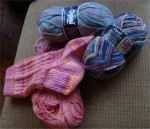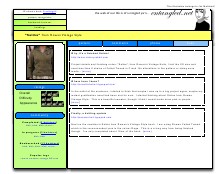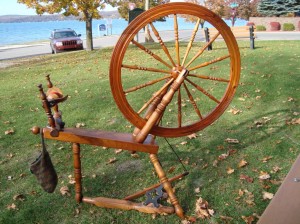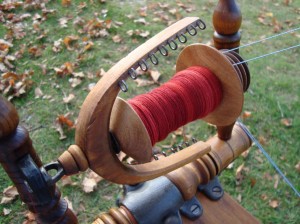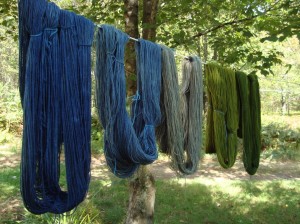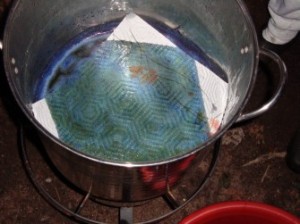The leaves are almost all off the trees now in northern Michigan. Our biggest maple is glowing with golden leaves for just a while yet. Many of the woods are bare branches and once again a sillouette against the sky. The evenings have been below freezing on several nights and the days range from high forties to high fifties. We’ve enjoyed our first fire in the fireplace for the season. 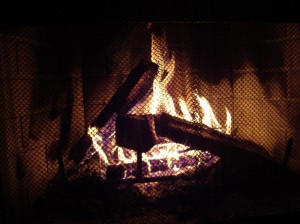 Today is overcast and raining, a great way to experiment with ambient lighting from a low light source.I decided to put to use two photography tips I had just learned. Photograph near a window and not in direct light. Place your camera perpendicular to the light source. Use your camera on low light (twilight) setting with no flash. I learned the first from an interview Jared “Brooklyn Tweed” on the Sticks and Strings podcast with David. The last tip is from the podcast Knitmore Girls, Episode 121, Hot Glue. While listening to this episode I felt your pain when discussing nupps. I too dreaded doing the nupps in the Echo Flower shawl I did and the Aeolian that I am currently working on. I found this wonderful, easy way to do nupps without tears.
Today is overcast and raining, a great way to experiment with ambient lighting from a low light source.I decided to put to use two photography tips I had just learned. Photograph near a window and not in direct light. Place your camera perpendicular to the light source. Use your camera on low light (twilight) setting with no flash. I learned the first from an interview Jared “Brooklyn Tweed” on the Sticks and Strings podcast with David. The last tip is from the podcast Knitmore Girls, Episode 121, Hot Glue. While listening to this episode I felt your pain when discussing nupps. I too dreaded doing the nupps in the Echo Flower shawl I did and the Aeolian that I am currently working on. I found this wonderful, easy way to do nupps without tears.
Wondering around Ravelry I saw a post about podcasts. I realized that I had not listened to any podcasts in probably a year. The hockey season has started and about after the third game in a week, I’m ready to plug in my podcast ears while working with my fiber project of the moment…and I mean moment. Taking photos this afternoon of everything I have in the works, either on the needles, hook or wheel there is a lot going on. No wonder I feel so busy.
Here’s the spinning projects at the moment I have in progress. The blue and gold is the colorway “Koi Pond” by AllspunUp on Etsy and on Ravlery. I am in the process of doing a plying exercise with this bump, hence all the sticky notes on the separate bumps. The brown and gold is Polwarth dyed by My8KidsMom and is being coordinated with a Polwarth by Southern Cross Fibres in Australia in darker shades of browns. I’m spinning both projects on my Minstrel wheel by Kromski. I’m doing each of the fibers separately in a 2 ply and then one skein will incorporate both fibers, one ply of each. Last but not least, is “Cherry Season” by Freckle Faced Fibers. The red is a beautiful cherry red merino that I am spinning on my antique spinning wheel, my CPW (Canadian Production Wheel) and creating a very fine 3 ply that I hope will be a light fingering weight for the Haruni Shawl. Perhaps the Polwarth is destined to become a hat or a scarf for a guy. A Christmas gift in the making? All of these projects are being done simultaneously. I’m not usually this scattered in my spinning, I’m still adjusting to being a multiple wheel person. Only having one wheel I stayed more on track and monogamous with my projects. Now I feel like a spinning slut.
I’ve been knitting one project while crocheting another. I picked up my Fair Isle sweater started in January 2008. I had only completed one complete sequence of the pattern and now I have two and starting on another. This pattern is in The Art of Fair Isle Knitting by Ann Feitelson. I listened to David’s interview with Ann on Sticks and Strings Podcast, Episode #64 as I knitted on my sweater last night. I like that there was mention in the interview that there is no ONE way to knit with two or more strands….or for anything in knitting, spinning or other fiber arts. Personally I knit fair isle holding one strand in either hand. That’s what is comfortable for me. What works for you or someone else is probably different. I normally throw with my right hand (US style). I hold the background in my right and throw and the pattern yarn is held in my left and picked Continental style. There are many different ways to hold your yarn in fair isle or other stranded knitting. If you’ve tried to do color knitting and didn’t feel comfortable, I urge you to try it again, a different way and find what is comfortable for you. I started working on this sweater to provide some stimulating knitting as a reward for crocheting a very basic baby blanket.
My niece recently had her third child, a boy after two beautiful girls. I started with two crochet patterns before settling on this one. The first required to much math to resize it from a regular sized afghan to a baby blanket. The second pattern was the right size but the pattern was to fussy for me to have an easy and quicker project. I did want to finish the baby blanket before the baby started school. Don’t laugh….don’t ask me about my daughter’s quilt. Anyway without any further adieu. This pattern turned out to be so easy it quickly became a bit boring. The cure for that was my Fair Isle sweater mentioned above. Once I’ve made enough progress in one sitting on the crocheting I reward myself with a row or two of stranded knitting with two colors. It keeps my fiber pursuits much more exciting. I had hoped to finish the baby blanket this weekend. I measured last night and have 28″ so far and I need 45″ to be done. After all the white is crocheted the blue chains for the plaid are added and the border crocheted around to finish it off. The plaid is only visible on one side. I made it in an acrylic yarn to insure easy laundry care for mom. He was born Sept. 13, 2010 so I’m already a little late.
A new form of spinning for me is on a supported spindle. This one is a Russian spindle by Spanish Peacock that I am spinning some Pygora on. It took some time and practice to get it spinning efficiently. It is slow going but a great way to control the twist and drafting for some gossamer weight wool. The Russian spindles are often used for spinning goat fiber for an Orenburg shawl. I could make some yarn for this type of lace project. But to spin this the traditional way I should ply it with silk. So many other projects already waiting in the wings.
I always have a pair of socks on the needles, the portable project of every knitter. The only problem is these socks have been everywhere. I’ve only been working on them for the entire summer. A pair of socks for my daughter are on the needles and the two yarns for upcoming socks.
I’m reading the Yarn Harlot’s latest book (at least it’s the last one I bought), Free Range Knitter: The Yarn Harlot Writes Again. When I’m not knitting, I’m reading about knitting and laughing along with Stephanie. Living in northern Michigan I can definitely relate to the heat wars she writes about. I am actually north of some areas of Canada….what do you think about that, eh?




